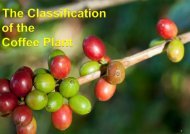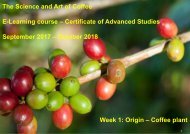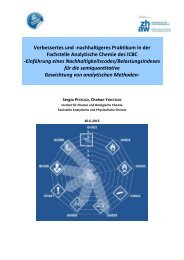You also want an ePaper? Increase the reach of your titles
YUMPU automatically turns print PDFs into web optimized ePapers that Google loves.
Here is a first slide that lists famous, traditional Arabica varieties (taken from Illy 2006). Some <strong>of</strong> those<br />
Arabica varieties can be distinguished botanically, e.g. C. arabica var. laurina with pointy leaves and seeds<br />
and C. arabica var. bullata with round leaves, but <strong>the</strong>y do not form a natural taxon.<br />
The two most renowned Arabica varieties are <strong>the</strong> oldest and worldwide distributed Typica and Bourbon.<br />
They were <strong>the</strong> start <strong>of</strong> many o<strong>the</strong>r varieties and <strong>the</strong>y exhibit excellent cup qualities. Some countries are<br />
famous for <strong>the</strong>ir renowned varieties that also provide excellent cup pr<strong>of</strong>iles, e.g. SL 28 and SL 34 in Kenya<br />
or Blue Mountain in Jamaica or Kona in Hawaii.<br />
O<strong>the</strong>r varieties were selected because <strong>of</strong> <strong>the</strong>ir higher productivity, e.g. dwarf varieties Catuai and Caturra<br />
that can be <strong>plant</strong>ed at higher densities. Both varieties are widely distributed in Central and South America,<br />
but <strong>the</strong>y are both on <strong>the</strong> downgrade due to susceptibility diseases. Also Villa Sarchi and Pacas are dwarf<br />
varieties, which are less distributed than Caturra or Catuai.<br />
Few varieties were selected because <strong>of</strong> <strong>the</strong>ir higher resistance against pests and diseases, e.g. Kent in<br />
Kenya, o<strong>the</strong>r were selected because <strong>of</strong> higher yield, e.g. Mundo Novo in Brazil, Tekesik in Central America.<br />
Also in Ethiopia, several varieties became famous, named after <strong>the</strong> region where <strong>the</strong>y were grown, e.g.<br />
Jimma, Harar, Yirga Chefe.<br />
To be considered a distinct Arabica variety, <strong>the</strong> must meet some criteria<br />
• The variety is homogenous: precise description by set <strong>of</strong> characteristics and all <strong>plant</strong>s look <strong>the</strong> same.<br />
• The variety is different: It is distinguishable from o<strong>the</strong>r varieties based on <strong>the</strong> above characteristics.<br />
• The variety is stable: The variety can be reproduced in such a manner that its characteristics are<br />
unchanged in <strong>the</strong> next generation.<br />
35








